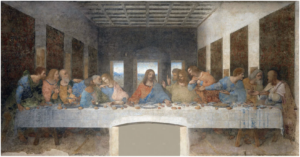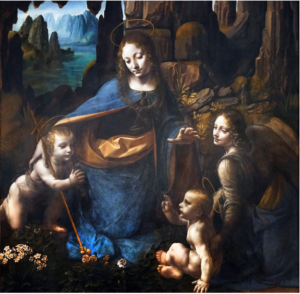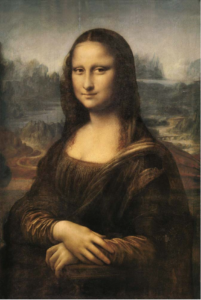Catalog Essay
Leonardo da Vinci is a very famous artist who is born in Italy. He began his art journey at the age of 14. Besides his art journey, he was also an architect and an inventor. He is a very talented individual. The High Renaissance period flourished in Rome from 1490 to 1527. The High Renaissance period was a time of great artistic and cultural innovation, characterized by a renewed focus on the human form and the human experience. Through their art, artists such as Leonardo da Vinci and Michelangelo sought to capture the beauty and complexity of the human experience, exploring themes such as portraiture, emotion, and the human body. Their famous works continue to inspire and influence artists today. The format of this exhibition is a monographic exhibition. It will be focused on the work of Leonardo da Vinci during the High Renaissance period. Through Leonardo da Vinci’s attention to detail, Leonardo was able to capture both the physical appearance and emotional expression of his subjects in human form.
Through a selection of eight key works, including The Last Supper, Virgin of Rocks, The Virgin and Child with Saint Anne, Portrait of Man in Red Chalk, Head of a Young Woman, La Belle Ferronniere, Saint John the Baptist, and La Scapigliata, we will explore more about Leonardo da Vinci’s remarkable artistic work and his legacy. In Leonardo’s portraits such as the Portrait of Man in Red Chalk and Head of a Young Woman, it shows his remarkable skill in capturing very detailed and unique features of the people he is painting. The Portrait of Man in Red Chalk is of an elderly man with a long beard and wrinkled face. The Head of a Young Woman captures a woman’s beauty and facial expressions. The two paintings look very realistic and looked like there was a lot of effort put into them to make them look like perfection. Additionally, La Belle Ferronniere is a portrait of an unknown woman and La Scapigliata is of a young woman with loose hair. These two paintings of women convey powerful emotional expression. Leonardo da Vinci was able to use anatomy to create these beautiful artworks. The artworks are so detailed that it looks like a photocopy. The anatomy shown in the paintings was very accurate and impressive. To not have many resources as we have today, he was able to turn many paintings into accurate and expressive paintings.
Leonardo da Vinci had numerous paintings with the theme of religion. However, even with the theme of religion, he includes a humanistic aspect. One of the most famous religious artworks of this time was The Last Supper. This is a painting that captures the night of Passover where Jesus is making amends for sins committed by Adam and Eve. The painting looks very realistic. He was able to capture their facial expressions and body language. This painting is an incredible way of showing events in Christian history. Another religious artwork made by Leonardo da Vinci is called The Virgin of the Rocks. The painting is of Virgin Mary with baby Jesus and John the Baptist. From looking at this painting, you can see that he focused on their facial expressions. Baby Jesus is also reaching out to John the Baptist in this painting as John the Baptist then points at him. Additionally, the painting called The Virgin Child with Saint Anne is also another beautiful artwork that represents religion. This artwork was of Virgin Mary, her mother Saint Anne, and baby Jesus. The expressions on the faces of the figures are subtle. Especially with Saint Anne giving off a sense of maternal warmth and the Virgin Mary radiating a sense of serenity. Lastly, the portrait of Saint John the Baptist is a portrait of a very important religious figure. Through his attention to detail, da Vinci is able to capture the complex emotions and relationships between the figures.
To be able to capture the details, characteristics, and personality of the person shows the talents of Leonardo. Through the examination of his works, such as The Last Supper, Virgin of Rocks, The Virgin and Child with Saint Anne, Portrait of Man in Red Chalk, Mona Lisa, La Belle Ferronniere, Saint John the Baptist, and La Scapigliata, we can see how he created artworks that are not only visually stunning but also convey a powerful sense of emotion and human experience. From looking at some of his most famous paintings, it is evident that religion played an important role in Leonardo’s art. He is very famous for his creation in his paintings and is very detailed oriented. His understanding of anatomy also shows in his artwork. Da Vinci’s legacy as one of the most talented artists of the High Renaissance continues to influence and inspire artists to this day.

The Last Supper
by Leonardo da Vinci
1495-1498
Dimensions: 15’1 x 29’0
Medium: Tempera
Located Currently: Santa Maria delle Grazie church in Milan, Italy
“The Last Supper” is a famous mural depicting the final meal shared by Jesus Christ and his disciples. Painted by the artist Leonardo da Vinci, this iconic masterpiece captures the profound emotions and tension within the scene. Leonardo da Vinci uses a material called tempera to create this beautiful painting. The composition skillfully portrays the moment when Jesus announces the betrayal among the twelve apostles. Leonardo’s meticulous attention to detail and the masterful use of light and shadow make “The Last Supper” a timeless work of art. Despite its deteriorated state, the painting’s historical significance and spiritual depth continue to resonate with viewers.

The Virgin of the Rocks
By Leonardo da Vinci
1483-1486
Dimensions: 78.3in x 48.0in
Medium: Oil paint on wooden panel
Located Currently: Louvre, Paris
“Virgin of the Rocks” is a beautiful masterpiece by Leonardo da Vinci that explores the theme of the Virgin Mary and baby Jesus in a landscape. In this painting, the holy figures are two holy angels. Behind them, they are surrounded by dark rocks. Leonardo’s innovative use of chiaroscuro, which is a technique used for woodcut print, is brilliant. The delicate depiction of nature and the tender expressions of the figures create a sense of harmony. The painting invites viewers to contemplate the bond between the mother and child. “Virgin of the Rocks” showcases Leonardo’s exceptional artistic skill. His ability to create an artwork spirituality and leave a lasting impression on all who encounter this mesmerizing artwork.

The Virgin and Child with Saint Anne
By Leonardo da Vinci
1503-1519
Dimensions: 5’6 x 5’8
Medium: Oil painting on wood
Located Currently: Louvre, France
“The Virgin and Child with Saint Anne” is a painting by Leonardo da Vinci that depicts the Virgin Mary seated on the lap of her mother who is Saint Anne and while embracing the baby Jesus. This monumental artwork shows how Leonardo was able to use his mastery of composition as he skillfully creates a connection between the three figures. Leonardo’s way of creating the figures’ expressions and gestures helps others view the painting with a sense of intimacy. The details and the interplay of light and shadow further enhance the scene’s realism. “The Virgin and Child with Saint Anne” showcases Leonardo’s ability to capture human emotions and relationships, making it a profound portrayal of maternal love and the divine bond between generations.

Portrait of a Man in Red Chalk
By Leonardo da Vinci
1510-1515
Dimensions: 1’1 x 0’9
Medium: chalk on paper
Located Currently: Royal Library, turin
“Portrait of a Man in Red Chalk” is an amazing portrait that presents a man with an intense stare. His facial features in the portrait are precisely created with red and black chalk on paper. Leonardo was able to capture the man’s facial expression and the anatomy of the human body in this painting. He was able to use chiaroscuro to highlight the outline of the face. This impressive artwork provides a glimpse into Leonardo’s exceptional ability to create a portrait of a person and his dedication to understanding human anatomy. This portrait definitely looks very realistic and everything about this portrait is very precise.

La Scapigliata
By Leonardo da Vinci
1508-1510
Dimensions: 0’10 x 0.8
Medium: oil paint
Located Currently: Parma, italy
Leonardo da Vinci’s “La Scapigliata” is created showing its picture of a young woman lost in thought. The woman’s loose, flowing hair shows a sense of vulnerability and she looks very natural. Her expression and distant stare give the painting a contemplative atmosphere. It also invites viewers to wonder what her thoughts are. Leonardo’s impressive technique is evident in his use of light and shadow making the painting look very realistic. It is shown in the detailing of her hair and the delicate detailing of her face. “La Scapigliata” serves as an example showing Leonardo’s ability to capture the complexity of human emotions and features.

Saint John the Baptist
By Leonardo da Vinci
1513-1516
Dimensions: 2’3 x 1’10
Medium: oil on wood
Located Currently: Louvre, france
Leonardo da Vinci’s “Saint John the Baptist” is a masterpiece that showcases the artist’s profound understanding of human anatomy. The painting depicts Saint John the Baptist, who is a key figure in the Christian tradition. You can see the emphasis on his expression and how he is pointing at the cross. Saint John the Baptist’s smile encourages reflection. Leonardo’s exceptional technique is evident in the play of light and shadow. His technique is shown in the detailing of the hair, fur, and skin texture. The painting gives off a spiritual sense and has others contemplate their own relationship with the divine.

Mona Lisa
By Leonardo da Vinci
1503-1506
Dimensions: 2’6 x 1’9
Medium: oil paint
Located Currently: louvre, France
The Mona Lisa, also known as La Gioconda, is one of the most famous paintings in the world that is created by Leonardo da Vinci during the High Renaissance. It showcases his exceptional skill and mastery of the techniques of his time. The woman in the painting is believed to be Lisa Gherardini who is a woman from Florence. Leonardo’s portrayal of her is impressive and he is able to capture her with a slight smile that gives a viewer warmth while looking at it. The use of sfumato which is a technique where colors and tones blend seamlessly gives the painting a sense of warmth. This technique is brilliant as it makes the portrait look very realistic. Despite its age, the Mona Lisa continues to captivate audiences worldwide. It is still highly talked about. Its ambiguous expression and beauty show how art really is and is able to connect with others through viewing this beauty.
Citations
- Cambiaghi, & Hausse, H. (2019). Leonardo da Vinci (1452–1519) and the legacy of a “Renaissance neurologist”: 500 Years after. Neurology, 93(16), 717–718. https://doi.org/10.1212/WNL.0000000000008333
- Jones, Muffet. “High Renaissance.” Introduction To Art, 2018. https://boisestate.pressbooks.pub/arthistory/chapter/high-renaissance/#:~:text=The%20High%20Renaissance%20was%20centered,and%20their%20works%20were%20harmonious.

